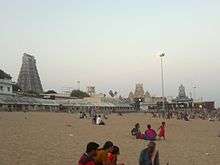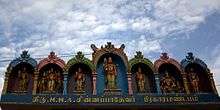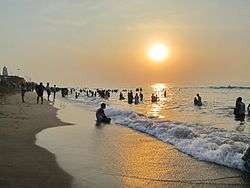Thiruchendur
| Tiruchendur திருச்செந்தூர் Tirucheer Alaiwai | |
|---|---|
| Town | |
|
Tiruchendur beach | |
 Tiruchendur Location in Tamil Nadu, India | |
| Coordinates: 8°29′00″N 78°07′00″E / 8.4833°N 78.1167°ECoordinates: 8°29′00″N 78°07′00″E / 8.4833°N 78.1167°E | |
| Country |
|
| State | Tamil Nadu |
| District | Thoothukudi |
| Elevation | 3 m (10 ft) |
| Population (2011)[1] | |
| • Total | 32,171 |
| Languages | |
| • Official | Tamil |
| Time zone | IST (UTC+5:30) |
| PIN | 628215 |
| Telephone code | 04639 |
| Vehicle registration | TN-92( TN-69 till Jun17,2015) |
| Nearest city | Thoothukudi |
| Sex ratio | 1000 : 1018.58 ♂/♀ |
| Literacy | 79% |
| Lok Sabha constituency |
Thoothukudi Formerly with Tiruchendur |
| Vidhan Sabha constituency | Tiruchendur |
| Website |
www |
(Tamil:திருச்செந்தூர்) Tiruchendur is a panchayat town at the southern tip of India, in the Thoothukudi district of Tamil Nadu. It is home to Thiruchendur Murugan Temple, one of the ancient Hindu temples dedicated to Lord Muruga.[2][3]
Geography
The suburban villages surrounding the town contain arid, red soil forests that are densely planted with palm trees, cashew plantations, and other crops typical of the region.
Demographics
As of the 2001 Indian census, Tiruchendur had a population of 29,330.[4] Males constitute 50% of the population and females 50%. Tiruchendur has an average literacy rate of 79%, higher than the national average of 59.5%. Male literacy is 82%, and female literacy is 76%. In Tiruchendur, 12% of the population is under 6 years of age.
Transportation
The town is connected by rail and road. The Tuticorin Airport is about 40 kilometres (25 mi) from Tuticorin, 55 km (34 mi) from Tirunelveli, and 171 km (106 mi) from Madurai.[5] Currently, Spice Jet operates one inbound and outbound flight to Chennai. There are bus connections to Aruppukkottai, Ettayapuram, Tuticorin, Kovilpatti, Sankarankovil, Madurai and Tirunelveli. The town is connected to Tirunelveli by a broad-gauge train track, with a train station at Thiruchendur. The Chendur Express train runs daily between Chennai Egmore Junction and Tiruchendur. Passenger train services are also available between Tirunelveli and Tiruchendur.
Education
- Aditanar College of Arts and Science, Tiruchendur
- Dr. Sivanthi Aditanar College of Education, Tiruchendur
- Dr. Sivanthi Aditanar College of Engineering, Tiruchendur
- Dr. Sivanthi Aditanar College of Nursing
- Dr. Sivanthi Aditanar College of Physical Education, Tiruchendur
- Dr. Sivanthi Aditanar Teacher Training Institute, Tiruchendur
- Govindammal Aditanar College for Women, Tiruchendur
- Wavoo Wajeeha Women's College of Arts and Science
Religion
An epic poem composed in the 17th century, known as Kapadapuram, relates that Muruga killed the demon, Surapadman, after a six-day battle.[6] The name, 'Tiruchendur', originated from 'Thiru', meaning sacred, because it was a battleground for Lord Muruga, and 'Senthur', meaning 'red place', because of the bloodiness of the battle. Many towns in Tamil Nadu have the same honorary prefix, including Tiruchirappalli, Tiruppur and Tirunelveli.
Temples
Tiruchendur Murugan Temple


Tiruchendur Murugan Temple is an ancient Hindu temple dedicated to Lord Muruga at the site of the battle. It is one of the six major abodes, or sacred temples, of the Kaumaram religion. Soorasamharam, a reenactment of the victory over Sarapadman, and Kanda Shasti, a devotional song in praise of Lord Muruga are performed at the temple.
The temple, which is built near the seashore, measures 91 m (299 ft) north to south, 65 m (213 ft) east to west, and has a seven-tier gopuram, or tower gate, that is 42 m (138 ft) high.[7] The principal entrance faces south, and opens into the first of two prakarams, the first of which is lined with rows of Yalis. The inner sanctum of the temple is in a cave and the main deity, or moolavar, is Murugan as a saintly child, portrayed in a granite carving.[6]
Naazhi Kinaru, a sacred well fed by a freshwater spring, is located 100 m (330 ft) south of the temple. Devotees undergo a ritual cleansing by bathing in water from the well after bathing in the ocean.[6]
Dutch Occupation of the Thiruchendur Temple
The Murugan temple at Thiruchendur was occupied by the Dutch East India company from 1646 to 1648, during the course of their war with the Portuguese. The local people tried to free their temple, with no success. The Dutch finally vacated the temple on orders from the Naik ruler. However, while leaving, they removed the idol of the main deity of the temple, and took it with them. Senthilaandavan appeared in a dream to Vadamaliyappa Pillai, an ardent devotee of Lord Muruga, and revealed the place in the sea where the idol had been abandoned. Vadamlaiyappa Pillai and Athitha Nadar, a sponsor of services in the Thiruchendur temple, went to the spot in a fishing boat and retrieved the idol in 1653. The story is shown in paintings inside the temple
Other temples
- Avathara Pathi, the site where Vishnu incarnated as Ayya Vaikundar and rose from the sea.
- Sri Ponvandu Aiyanar temple, in the village of Nainarpattu, near Thiruchendur.
- Chettiyapathu Sri Ainthu Veettu Swami Temple is situated at Udankudi, 2 km (1.2 mi) from Thiruchendur.
Churches
- CSI Christ Church
- Mother Mary Church Amaliannai Church
- ST.Thomas Church Veerapandian Patnam
Mosques
- Mohideen Masjid
Festivals and rituals
Festivals are celebrated throughout the year at the temple including Brahmothsavam in the month of Magha (February – March), Vasanthotsavam for 10 days in Chaitra (April – May), Visaka Visakam for 12 days in Vaisakha (May – June)[1] and Skandha Sashti in Ashvini (October – November). There are two Maha Utsavams called Aavanipperunthirunaal and Maasipperunthirunaal conducted and celebrated during Simharavi, in the Tamil month of Aavani (August–September), and Kumbharavi, in the Tamil month of Māsi (January–February). These 12-day festivals occur twice every year.
Masi Thiruvizha

Several lakh of people congregate for Masi Thiruvizha, a 12-day festival at Thiruchendur. The Kayamozhi Athitha Nadarhal Arakattalai Mandahapadi committee organises functions on the sixth and seventh days of the festival. On the tenth day of the festival, the presiding Lord of the Thiruchendur temple makes a special appearance in Thirunelveli Dakshinamara Nadar Sangam, in Sannidhi Street.
Several thousand devotees worship at the Masi Magam festival of the Sri Subramaniawamy temple at Tiruchendur. The festival was inaugurated by the Athitha Nadar clan several centuries ago and includes ritual performances, like Pali-vidalai eridhal.
Ippasi Lord Subramaniya's marriage ritual
In the month of Aippasi, when the ritual for Lord Subramaniya's marriage is performed, Athitha Nadars perform the ritual for the groom side, offering Thirumangalyam and the wedding feast. The bride's side wedding feast is arranged by Nattathi Nadars the next day.
Politics
The Tiruchendur assembly constituency was part of the Tiruchendur (Lok Sabha constituency) until 2009.[8] After dissolution of the Lok Sabha constituency in May 2009, the constituency was aligned with the Tuticorin Lok Sabha constituency. The current member of the legislative assembly (MLA) to Tamil Nadu assembly, elected by the general election 2011, is Anitha R. Radhakrishnan of Dravida Munnetra Kazhagam.
References
- ↑ "Census of India: Search Details". censusindia.gov.in. Archived from the original on 2016-03-04. Retrieved 2016-09-05.
- ↑ "Welcome To Lord Murugan.com Home Page". Lordmurugan.com. Retrieved 2015-09-07.
- ↑ "Tiruchendur". Thoothukudi.nic.in. Retrieved 2016-09-04.
- ↑ "Census of India 2001: Data from the 2001 Census, including cities, villages and towns (Provisional)". Census Commission of India. Archived from the original on 2004-06-16. Retrieved 2008-11-01.
- ↑ "(TCR) Tuticorin Airport". flightstats.com. Retrieved 2015-09-07.
- 1 2 3 Clothey, Fred W. (1978). The Many Faces of Murukan̲: The History and Meaning of a South Indian God. Walter de Gruyter. pp. 121–. ISBN 978-90-279-7632-1. Retrieved 2016-09-05.
- ↑ Knapp, Stephen (2009-01-01). Spiritual India Handbook. Jaico Publishing House. pp. 387–. ISBN 978-81-8495-024-3.
- ↑ "List of Parliamentary and Assembly Constituencies" (PDF). Tamil Nadu. Election Commission of India. Archived from the original (PDF) on 2009-03-04. Retrieved 2016-09-05.
External links
- Tiruchendur Nagara Viduthi
- Photos of Tiruchendur Nagara Viduthi
- Thiruchendur Murugan Kovil
- Chendur Murugan Kovil
- Tiruchendur Muruga
| Wikimedia Commons has media related to Thiruchendur. |
